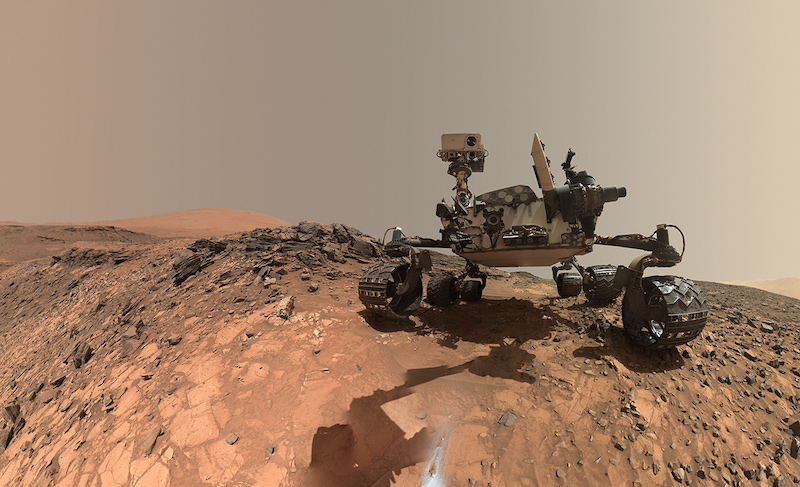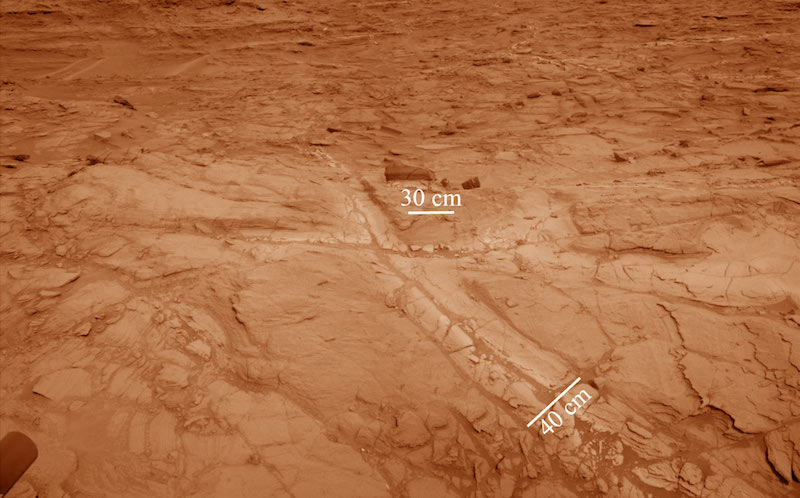
Over the past couple of decades, NASA’s rovers and orbiters have found increasing evidence for ancient liquid water on Mars. Now, the Curiosity rover has discovered another major clue: opal. Curiosity has been studying extensive fracture halos in Gale Crater. These halos are light-toned rocks that surround subsurface fractures in the ground. As it turns out, the halos are rich in opal, which forms in water-rich environments. Interestingly, scientists say that the halos and the cracks they surround are much younger geologically than most of the other rocks in Gale Crater. This shows that there was a lot more subsurface water around in the region, and more recently geologically, than previously thought.
Travis Gabriel at the USGS Astrogeology Science Center, and previously at Arizona State University, led the new research. The researchers published their intriguing and peer-reviewed new findings in JGR Planets on December 19, 2022.
Water-rich fracture halos and opal on Mars
Curiosity found the opal in water-rich fracture halos. There is a wide network of criss-crossing subsurface fractures in this region. The fractures are surrounded by lighter-toned rocks – the fracture halos – that can also be seen on the surface. Indeed, they appear in many of the images that Curiosity has sent back to Earth. They are widespread in the crater, and the rover also saw them much earlier in the mission after it landed in 2012.
Gabriel and his team wanted to re-study some of these previous fracture halos. They used new methods to analyze the data that Curiosity had collected. They found that the older halos are similar in composition to ones found later in the mission. Even though they are in completely different types of rock. The halos contain a lot of silica and water (in bound mineral form now, not liquid). And, as it turns out, opal. Gabriel said:
Our new analysis of archival data showed striking similarity between all of the fracture halos we’ve observed much later in the mission. Seeing that these fracture networks were so widespread and likely chock-full of opal was incredible.
Earlier analysis by Curiosity’s ChemCam spectrometer had suggested that the halos contained opal. By re-measuring some of the previous data of the halos, Gabriel and his team confirmed the presence of opal. Opal can form in solutions of silica and water. That analysis suggested that the halos were very unique, as Gabriel noted:
These light-toned rocks were lighting up in our neutron detector, producing anomalously high thermal neutron count rates.

A safe haven for life?
The discovery of opal also has implications for habitability on Mars. As has been noted, the subsurface water that filled the fractures and created the halos was widespread in the region and lasted a long time. This means it could have provided a hospitable environment for microorganisms to exist below the surface. There would have been more warmth and protection from the harsh radiation from the sun. Even long after the original lake in Gale Crater had dried up. Gabriel said:
Given the widespread fracture networks discovered in Gale Crater, it’s reasonable to expect that these potentially habitable subsurface conditions extended to many other regions of Gale Crater as well, and perhaps in other regions of Mars. These environments would have formed long after the ancient lakes in Gale Crater dried up.
Resource for future astronauts
Since opal itself is made up largely of water, future astronauts may be able to use it as a resource. You just have to grind the opal down and apply heat, and bingo, it releases water. According to Gabriel’s team’s calculations, a single-meter halo could contain roughly one to 1.5 gallons of water in the top foot of the surface.
Data from orbiting spacecraft also indicates that there is likely opal elsewhere on Mars as well. If any of those opal deposits contain as much water as the ones in Gale Crater, that could indeed be a great resource for astronauts exploring the red planet in the future.
While this opal may not be gemstones per se, it is still invaluable. And this discovery is thanks to Curiosity, which is still going strong on Mars after 10 years. As co-author Craig Hardgrove at Arizona State University noted:
It’s amazing to see Curiosity’s neutron detector, the rover’s only subsurface probe, which was originally only expected to survive for a few years into the mission, still providing fantastic results like these that reveal the nature of water and hydrated materials buried just below the Martian surface.
Bottom line: NASA’s Curiosity rover has found water-rich opal on Mars. Its presence indicates that there was an extensive and potentially habitable subsurface environment.
The post Discovery of opal on Mars boosts chances for life first appeared on EarthSky.
from EarthSky https://ift.tt/8tcrSj5

Over the past couple of decades, NASA’s rovers and orbiters have found increasing evidence for ancient liquid water on Mars. Now, the Curiosity rover has discovered another major clue: opal. Curiosity has been studying extensive fracture halos in Gale Crater. These halos are light-toned rocks that surround subsurface fractures in the ground. As it turns out, the halos are rich in opal, which forms in water-rich environments. Interestingly, scientists say that the halos and the cracks they surround are much younger geologically than most of the other rocks in Gale Crater. This shows that there was a lot more subsurface water around in the region, and more recently geologically, than previously thought.
Travis Gabriel at the USGS Astrogeology Science Center, and previously at Arizona State University, led the new research. The researchers published their intriguing and peer-reviewed new findings in JGR Planets on December 19, 2022.
Water-rich fracture halos and opal on Mars
Curiosity found the opal in water-rich fracture halos. There is a wide network of criss-crossing subsurface fractures in this region. The fractures are surrounded by lighter-toned rocks – the fracture halos – that can also be seen on the surface. Indeed, they appear in many of the images that Curiosity has sent back to Earth. They are widespread in the crater, and the rover also saw them much earlier in the mission after it landed in 2012.
Gabriel and his team wanted to re-study some of these previous fracture halos. They used new methods to analyze the data that Curiosity had collected. They found that the older halos are similar in composition to ones found later in the mission. Even though they are in completely different types of rock. The halos contain a lot of silica and water (in bound mineral form now, not liquid). And, as it turns out, opal. Gabriel said:
Our new analysis of archival data showed striking similarity between all of the fracture halos we’ve observed much later in the mission. Seeing that these fracture networks were so widespread and likely chock-full of opal was incredible.
Earlier analysis by Curiosity’s ChemCam spectrometer had suggested that the halos contained opal. By re-measuring some of the previous data of the halos, Gabriel and his team confirmed the presence of opal. Opal can form in solutions of silica and water. That analysis suggested that the halos were very unique, as Gabriel noted:
These light-toned rocks were lighting up in our neutron detector, producing anomalously high thermal neutron count rates.

A safe haven for life?
The discovery of opal also has implications for habitability on Mars. As has been noted, the subsurface water that filled the fractures and created the halos was widespread in the region and lasted a long time. This means it could have provided a hospitable environment for microorganisms to exist below the surface. There would have been more warmth and protection from the harsh radiation from the sun. Even long after the original lake in Gale Crater had dried up. Gabriel said:
Given the widespread fracture networks discovered in Gale Crater, it’s reasonable to expect that these potentially habitable subsurface conditions extended to many other regions of Gale Crater as well, and perhaps in other regions of Mars. These environments would have formed long after the ancient lakes in Gale Crater dried up.
Resource for future astronauts
Since opal itself is made up largely of water, future astronauts may be able to use it as a resource. You just have to grind the opal down and apply heat, and bingo, it releases water. According to Gabriel’s team’s calculations, a single-meter halo could contain roughly one to 1.5 gallons of water in the top foot of the surface.
Data from orbiting spacecraft also indicates that there is likely opal elsewhere on Mars as well. If any of those opal deposits contain as much water as the ones in Gale Crater, that could indeed be a great resource for astronauts exploring the red planet in the future.
While this opal may not be gemstones per se, it is still invaluable. And this discovery is thanks to Curiosity, which is still going strong on Mars after 10 years. As co-author Craig Hardgrove at Arizona State University noted:
It’s amazing to see Curiosity’s neutron detector, the rover’s only subsurface probe, which was originally only expected to survive for a few years into the mission, still providing fantastic results like these that reveal the nature of water and hydrated materials buried just below the Martian surface.
Bottom line: NASA’s Curiosity rover has found water-rich opal on Mars. Its presence indicates that there was an extensive and potentially habitable subsurface environment.
The post Discovery of opal on Mars boosts chances for life first appeared on EarthSky.
from EarthSky https://ift.tt/8tcrSj5

Aucun commentaire:
Enregistrer un commentaire